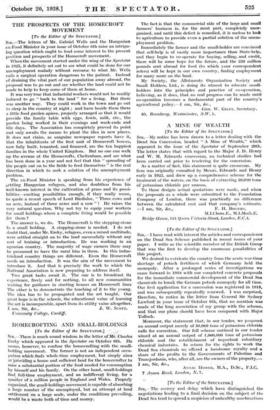THE PROSPECTS OF THE HOMECROFT . MOVEMENT • [To the Editor
of the SPECTATOR.]
SIR,—The letters of Mr. Gabriel Wells and the Hungarian ex-Food Minister in your issue of. October 6th raise an intrigu- ing question which ought to lend some interest to the present position and prospects of the Homecroft movement.
When the movement started under the wing of the Spectator in 1925, it definitely set out to see what could be done for our unemployment malady without recourse to what Mr. Wells calls a surgical operation dangerous to the patient. Instead of draining the vital part of our population away abroad, the proposal was to go out and see whether the land could not be made to help to keep some of them at home.
It was very true that industrial workers would not be readily Induced to go " back to the land " for a living. But there was another way. They could work in the town and go out to sleep in the. country at night ; and have beside them there a little food garden apiece, properly arranged so that it would provide the family table with eggs, fowls, milk, etc., the garden being worked in their evenings and week-ends and idle days. The Association has completely proved its point and only awaits the means to plant the idea in new places. It does not claim, as sanguine newspaper reports have it, that the inhabitants of the first unit of Homecroft houses, now fully built, tenanted, and financed, are the ten happiest families in the whole United Kingdom. But no one can walk up the avenue at the Homecrofts, Cheltenham, and see what has been done in a year and not feel that this " spreading of the people out on to the fields to feed themselves " is the real direction in which to seek a solution of the unemployment problem.
The ex-Food Minister is speaking from his experience of settling Hungarian refugees, and also doubtless from his well-known interest in the cultivation of grass and its possi- bilities—exciting possibilities enough, if they really mean, to quote a recent speech of Lord Bledisloe, " Three cows and an acre, instead of three acres and a cow " I He raises the very natural question, Why not try to equip your workers for small holdings where a complete living would be possible fOr them ?
The answer is, we do. The Homecroft is the stepping-stone to a small holding. A stepping-stone is needed. I do not doubt that, under Mr. Ereky, refugees, even a mixed multitude, were settled straight on to the land successfully without any sort of training or introduction. He was working in an agrarian country. The majority of wage earners there may be presumed to have the rural bias in them. In this indus- trialized country things are different. Even the Homecroft needs an introduction. It was the aim of the movement to introduce it. And that is precisely the work to which the National Association is now preparing to address itself.
Two great tasks await it. The one is to broadcast its experience, freely and for nothing, to all new communities wishing for guidance in starting houses on Homecroft lines The other is to demonstrate the teaching of it to the young. The idea has to be propagated and the art taught. Our great hope is in the scbools, the educational value of learning the art is incomparable, apart from its utility value altogether.






























































 Previous page
Previous page